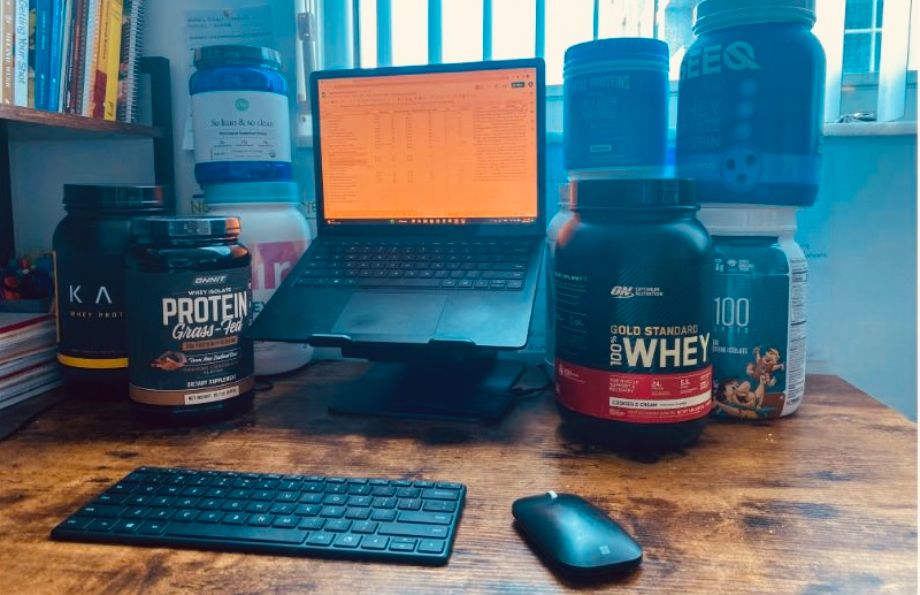We test and review fitness products based on an independent, multi-point methodology. If you use our links to purchase something, we may earn a commission. Read our disclosures.
Garage Gym Reviews worked with an independent accredited lab, Ellipse Analytics, to test and rate more than 150 protein powders for purity (measuring heavy metals, bisphenols, phthalates, and pesticides) and label accuracy (analyzing protein content). What do these purity criteria mean in relation to dietary supplements? Here’s your explainer:
Heavy Metals
Metals such as magnesium, calcium, iron, zinc, and copper, are naturally found in the soil and air. Not all metals are toxic, and some are even essential to a properly functioning human body (although all have limits!). “Many of the ingredients in your daily supplement routine are, in fact, metals,” says Dr. Sean Callan, a neuroscientist and CEO of Ellipse Analytics. “Zinc has been linked to immune support, and calcium is important for healthy bones.”
However, the ones that can cause harm even in small concentrations—oftentimes referred to as the RCRA 8, including arsenic, barium, cadmium, hexavalent chromium, lead, mercury, selenium, and silver—are also often referred to as heavy metals. They can contaminate the soil via chemicals like fertilizers and pesticides and are present in low levels in just about all food.
“We call them the ‘heavy’ metals because in the 1800’s, people started noticing that metals that made people sick tended to be especially dense,” says Dr. Callan. “Just like other metals, these toxic heavy metals occur naturally in the earth’s soil, though they’re more concentrated in some places in the world than in others. They get absorbed by plants just like beneficial minerals and are in turn absorbed by animals who eat the plants (including humans). This means that when you buy products from the grocery store, there’s a chance the products contain measurable levels of these contaminants.”
The risk to us is that heavy metals are bioaccumulative, which means that they can build up over time in plants and animals. Chronic exposure to unsafe levels of heavy metals can cause cancer, kidney and immune system dysfunction, as well as vascular damage and birth defects.
“Though these heavy metals do occur naturally—and are typically found in food in levels below what would cause an immediate risk to health—over time, exposure can build up and become harmful,” says Dr. Callan. “As scientists learn more about these toxic metals, we become increasingly convinced that our goal should be to minimize exposure, especially for vulnerable populations. For example, it is the position of most major medical authorities including the American Medical Association, the U.S. Food and Drug Administration, and the World Health Organization that there is no safe level of lead. As these metals occur naturally, achieving ‘absolute zero’ is not possible, but seeking out products that have been tested by a third party is a good way to reduce your overall exposure.”
Bisphenols
Bisphenols, particularly bisphenol A, is a chemical used to make certain plastics and resins, like the ones foods and supplements come packaged in. Research has shown that BPA can seep into food from the containers, and BPA exposure has been linked to possible health problems in fetuses, infants, and children. However, the FDA says that BPA is safe at the very low levels that occur in foods, based on hundreds of studies that have been done on the topic.
“The good news with bisphenols, like BPA, is that food manufacturers have largely taken steps to avoid introducing BPA into their products by avoiding using plastics that contain bisphenols,” explains Dr. Callan. “Despite this, we do sometimes see ‘BPA-free’ claims that are not true—so, it’s always a good idea to buy products from companies that have been third-party tested.”
Phthalates
Phthalates are another chemical used in plastic products often found in food packaging and food handling equipment. They’ve, again, been linked to health concerns among pregnant women and children, but similar to bisphenols, they are considered safe at very low levels.
Pesticides
This one you might be more familiar with. Pesticides are chemicals used to control insects, rodents, weeds, and even bacteria and fungus, in the food production system. The EPA regularly evaluates pesticides that are used on foods to ensure that they won’t pose harm to anyone who consumes them.
“There are thousands of pesticides out there, ranging from largely harmless to humans to extremely toxic,” says Dr. Callan. “Seeking out products with third-party certifications like organic can help reduce your exposure to these chemicals, but even organic products sometimes contain pesticide residues; very few organic-certified products are ever actually tested for pesticide residues as part of the certification process. The best way to avoid pesticides is—as with metals and bisphenols—to buy products that have been tested for pesticides by a third party.”
The Bottom Line
One very important note here about all of these contaminants is that just because one of these them is detected, does not mean that the supplement is immediately harmful. All food contains some of these, so it’s important to be able to assess how much is there—which is what we did with this testing—and then consider how frequently a person is exposed to said contaminant to help determine what your personal risk is.
Further reading

We asked a certified strength and conditioning coach to build a beginner core workout with the best core exercises to boost strength and sculpt your abs. Read more

Barbell curls aren’t the only way to grow your biceps, as proven in our bodyweight bicep workout guide. No weights or gym required. Read more

Stronger core muscles, greater mobility, and better sex? The pelvic tilt exercise boasts these benefits and more! Check out our expert guide right here! Read more

Is the beloved Ohio Power Bar the best powerlifting bar available? Find out in our Rogue Ohio Power Bar review. Read more

